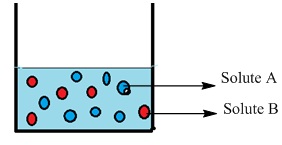Mole Fraction Formula
Mole fraction may be a unit of concentration in chemistry. A mole is really a variety of molecules, approximately 6 × 1023. A mole fraction is the ratio of molecules of 1 component during a mixture. For instance, if the mole fraction of methane in gas is 0.90, then this suggests that 90% of the molecules are methane. Since the quantity fractions are like mole fractions, the mixture is additionally 90%, by methane. During this article, we’ll discuss the mole fraction formula, its properties, and solved examples.
Mole Fraction Formula
Mole fraction of every solute = number of moles of that solute/ the entire number of moles of all solutes and also the solvent.
It is just like the amount fraction. The lowercase Greek letter χ (chi) rather than a Roman x are the notations of mole fraction. For mixtures of gases, IUPAC recommends the letter y. It is a method of expressing the composition of a mix with a dimensionless quantity, the mass fraction (percentage by weight, wt%) and volume fraction (percentage by volume, vol%).

Source: www.examfear.com
The advantage of the dimensionless mole fraction scale is that within the absence of reaction, the mole fraction of chemical substance k is independent of both temperature and pressure. The utilization of the mole fraction allows the calculation to be made for mixtures of gases.
Properties of Mole Fraction
Mole fraction is employed very frequently within the construction of phase diagrams. it’s not temperature-dependent (such as molar concentration) and doesn’t require knowledge of the densities of the phases involved. A mix of known mole fraction is often prepared by weighing off the acceptable masses of the constituents.
The measure is symmetric: within the mole fractions, x = 0.1 and x = 0.9, the roles of ‘solvent’ and ‘solute’ are reversed. during a mixture of ideal gases, the mole fraction is often expressed because of the ratio of partial pressure to the entire pressure of the mixture. During a ternary mixture, one can express mole fractions of a component as functions of other components mole fraction and binary mole ratios.
Mole fraction is beneficial when two reactive components are mixed together because the ratio of the 2 components is understood if the mole fraction of every is understood. Multiplying mole fraction by 100 gives a mole percent, which describes an equivalent thing as mole fraction, just during a different form.
Solved Examples for Mole Fraction Formula
Q] A Solution contains 30% by mass in carbon tet. Calculate the mole fraction of benzene using Mole Fraction Formula.
Solution: Total mass of the answer = 100 g
Mass of benzene = 30 g
Therefore, mass of carbon tet = (100 – 30)g
Benzene’s molar mass (C6H6) = (6 × 12 + 6 × 1) g mol – 1 = 78 g mol – 1
Hence, C6H6’s number of moles =30/78 mol = 0.3846 mol
Molar mass of carbon tet (CCl4) = 1 × 12 + 4 × 355 = 154 g mol – 1
∴ CCl4’s number of moles = 70/154 mol = 0.4545 mol
Mole fraction of C6H6 = [number of moles of C6H6 / number of moles of C6H6 + number of moles of (CCl4) ] X 100%
= 0.3846/ 0.3846+ 0.4545 = 0.458
Q] Determine the mole fraction of methanol CH3OH and water during a solution prepared by dissolving 5 g of alcohol in 50 g of H2O. M of H2O is eighteen and M of CH3OH is 32.
Solution: Moles of CH3OH = 5 / 32 = 0.1562 mole
Moles of H2O = 50 / 18 = 2.77 moles
Therefore, consistent with the equation
mole fraction of CH3OH = 0.1562 / 2.77 + 0.1562
= 0.0533